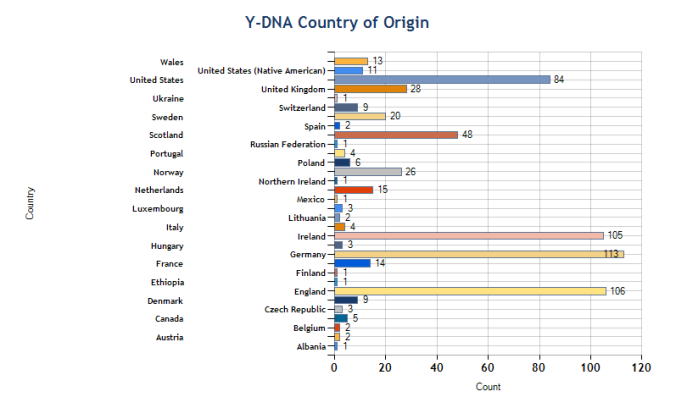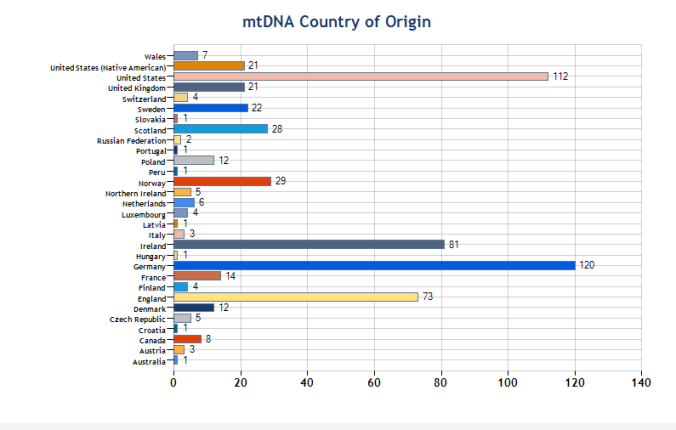The Iowa DNA Project, formed in November 2014 has now reached 1071 members. Categorized as ‘geographical’, the project is designed for those who have direct ancestors who lived in Iowa, or those researching collateral lines that lived in Iowa. Our focus is on those who have taken autosomal, aka Family Finder tests. However, we also have numerous members enthusiastically investigating their mtDNA and YDNA origins.
Those new to DNA testing are especially welcome and their research aims are supported and encouraged within the project. If you have tested with another company, you may wish to transfer your results to FTDNA and join us. Instructions are available here.
Key Figures
- Total Iowa DNA Project Members: 1071
- Family Finder Tests Completed: 930
- Average number of database wide matches per member: 1244
- Weekly New Member Inter-Project Match Updates
- All Iowa Counties Researched and Represented
Nuts and Bolts
The Iowa DNA Project Surname Index can be found here. Surnames associated with specific counties can be found in our FAQ here. Current members, if you’ve not already uploaded a gedcom and entered your surname and most distance ancestor details, you are strongly encouraged to do so! You can get detailed instructions on how to complete your profile here.
As you can see from the figures below, members have worked diligently to complete their profiles, thus increasing their odds of making the connection that will break down a brick wall.
- Total Iowa Surnames: 1276
- Members with Family Trees: 727
- Members with listed Surnames: 850
- Members with listed Most Distant Ancestors: 756
Iowan Family Groups
The long term goal of the Iowa DNA Project is the inclusion of multiple generations and extended family members who have taken the Family Finder test. These family groups assist in helping inter-project matches determine how they may be connected and which branch of their family trees to examine further. We have teamed up with Göran Runfeld of dnagen.net to trial his ICW Tool to map out the inter-connectedness of the entire Iowa DNA project. Below is the ‘Atlas’ or a graphical depiction of the current connections between our members.

Inter-Connectedness Atlas
Using the ICW Tool gives Iowa DNA Project members easy access to a variety of additional information and charts including a tabulation of our members’ Suggested Relationships. As you can see, our members are actively recruiting close family members to test.
Suggested Relationships
- Parent/Child: 240
- Full Siblings: 200
- 1st Cousin: 70
- 2nd Cousin: 280
- 3rd Cousin: 450
- 4th Cousin: 1160
More can be learned about the process and results here*.
*Detailed information, filters and charts are available to Iowa DNA Project members. Current members, if you would like to find your kit(s) in the Atlas , choose ‘KIT’ from the ‘FILTER’ drop down button on the left and enter your kit number(s).
Haplogroups
Project YDNA: As expected, the most common Y haplogroup remains R and its subclades, with I and its subclades the second most common. To date, 58 project members have completed the Big Y test and 119 have completed the Y-DNA111. If you are interested in getting closer to your terminal SNP but are put off by the price tag of the Big Y, there are numerous reasonably priced SNP packs available to help get you further down the phylotree*.
As you can see from the results below, members have taken advantage of the recent sales and discounts to get closer to their terminal SNPs, particularly those who had been languishing in the R-M269 subclade.
Member YDNA Haplogroups:
- R-M269: 159
- R (excluding R-M269): 104
- I: 72
- E: 13
- J: 10
- G: 9
- N: 3
- Q: 2
- B: 1
- C: 1
- T: 1
More information on the project’s patriarchs and YDNA results can be found here.
*If you are unsure, check with your Haplogroup’s administrator for guidance on which SNP pack is suitable for you.
The most common mtDNA continues to be H and its subclades with a variety of other haplogroups also represented. The representation of haplogroups by project members has remained stable since the previous quarterly. Currently, 303 project members have completed Full Mitochondrial Sequencing.
Member mtDNA Haplogroups:
- H: 162
- U: 46
- T: 42
- K: 37
- J: 34
- W: 11
- V: 9
- I: 9
- HV: 4
- L: 3
- X: 3
- A: 2
- B: 2
- N: 2
- HVO:2
- C: 1
- RO: 1
Complete information on our project’s mtDNA matriarchs, statistics and mutations can be found here.
Declared Countries of YDNA and mtDNA Origin


MyOrigins Leaderboard
On April 7, myOrigins was updated to myOrigins 2.0. Per the release notes, “Seeing your results change does not mean that they were incorrect before, but rather, that with more research and the addition of more reference populations we are able to paint a clearer picture of your genetic tapestry. As our database grows, we are able to gain a better understanding of the unique genetic variation for each of our reference populations and even add new reference populations to our existing regions. We will also share these advances with you and continue to refine your results.” As a result of the changes, lively discussions have sprung up at the official FTDNA forum.
Based on percentage points per member, the current Iowa DNA Project populations are listed below in order of frequency. Descriptions of each population cluster can be found here.
- British Isles 36,976
- West and Central Europe 19,462
- Scandinavia 9678
- East Europe 4738
- Southeast Europe 3892
- Iberia 1286
- West Africa 507
- Asia Minor 443
- Finland 290
- North and Central America 266
- Ashkenazi 230
- Sephardic 215
- West Middle East 143
- South America 109
- Northeast Asia 73
- East Middle East 32
- East Central Africa 23
- Central Asia 19
- South Central Africa 11
- North Africa 11
- South Central Asia 5
- Siberia 2
With the newest version of myOrigins, population trace amounts are also available in the ethnicity report.
- Sephardic 23 members
- Ashkenazi 48 members
- North and Central America 79 members
- South America 87 members
- British Isles: 7 members
- Scandinavia 24 members
- Finland 130 members
- West and Central Europe 6 members
- Southeast Europe 85 members
- East Europe 104 members
- Iberia 23 members
- West Middle East 60 members
- East Middle East 47 members
- Asia Minor 63 members
- North Africa 45 members
- East Central Africa 28 members
- South Central Africa 53 members
- West Africa 44 members
- Central Asia 53 members
- South Central Asia 37 members
- Siberia 31 members
- Northeast Asia 17 members
- Southeast Asia 16 members
- Oceania 101 members
As the results have been tracked since the inception of the project, it is possible to compare the current results above to the results of the previous version of myOrigins.
- British Isles 45,621
- Western and Central Europe 27,325
- Scandinavia 26,446
- Southern Europe 7,687
- Eastern Europe 5,382
- Finland and Northern Siberia 874
- Asia Minor 772
- West Africa 398
- Ashkenazi Diaspora 300
- Eastern Middle East 287
- Native American 237
- Central Asia 233
- Northeast Asia 143
- (Blended Population Cluster) Eastern, Western and Central European 100
- ECW Euro 100
- North Africa 87
- East Central Africa 16
- South-Central Africa 9
100% Club:
Previously, the Iowa DNA project had 19 members returning a 100% result of a single population cluster. Following the update, two members of our total 1071 have returned a 100% result (British Isles and Eastern Europe).
Ancient Origins
FTDNA has added the Ancient Origins calculator to its list of offerings, and describes it as, “The European Continent has been witness to many episodes of human migration, some of which have spanned over thousands of years. The most up-to-date research into these ancient migrations on the European Continent suggests that there were three major groups of people that have had a lasting effect on present day peoples of European descent: Hunter-Gatherers, Early Farmers, and Metal Age Invaders.” Now, those who have taken the Family Finder test can also learn more about their deep origins.
In general, across the board project members are returning roughly equal proportions of Hunter Gatherer and Early Farmers, with additional 10-15% Metal Age Invader ancestry. Detailed information on the calculator and how to use this new tool can be found here .
Ancient Origins Leaderboard
- Hunter Gatherers 35,722
- Early Farmers 34,209
- Metal Age Invaders 9872
- Non-European 930
Coming Results:
The FTDNA lab is currently waiting for the following test kits to be returned:1 Family Finder, 6 mtDNA Full Sequence, 1 Big Y, 2 YDNA 111 and 1 Factoid.
From the FTDNA lab, project members are waiting for the following results: 7 mtFull Sequence, 1 mtDNA Plus, 1 YDNA 37, 2 YDNA 67 (1 delayed), 4 YDNA 111 (1 delayed), 3 Big Y, 1 Y Haplogroup Backbone (delayed), 7 SNP Pack (2 delayed), 2 individual SNPs and 4 Family Finders.
Current members, please keep in mind you cannot be checked for inter-project matches without a completed Family Finder test.
Do You have Iowan Roots?
If you have Iowan roots, you are very welcome to join and encouraged to collaborate, share your family’s history, and find connections with your fellow Iowans.
You can read more about the benefits of joining a project at FTDNA here . If you would like to join the Iowa DNA Project, please visit our homepage here. The project has converted to MyGroups and has activated its Activity Feed to encourage collaboration. The Feed may be accessed after joining and of course our links section, which contains tutorials for FTDNA users and case studies, is available to all.